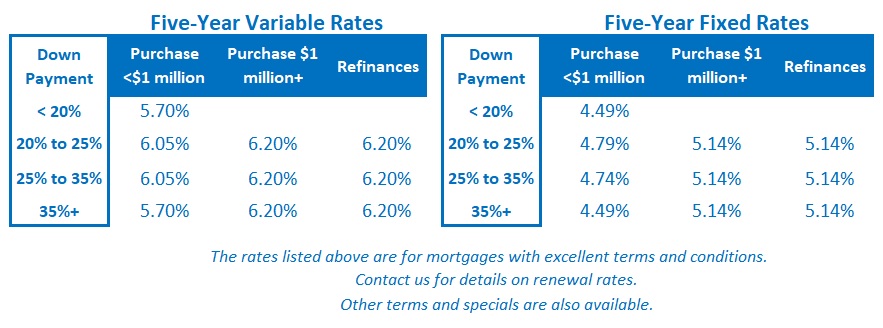Will the Bank of Canada Raise Again This Week?
January 23, 2023Was the US Federal Reserve’s Most Recent Hike Really That Dovish?
February 6, 2023 The Bank of Canada (BoC) hiked by another 0.25% last Wednesday. Its policy rate now stands at 4.50% after the most rapid series of increases we have seen since World War II. (As a reminder, the BoC’s policy rate was 0.25% on March 1, 2022.)
The Bank of Canada (BoC) hiked by another 0.25% last Wednesday. Its policy rate now stands at 4.50% after the most rapid series of increases we have seen since World War II. (As a reminder, the BoC’s policy rate was 0.25% on March 1, 2022.)
The Bank also announced that it will pause from making any additional hikes over the near term. The impacts from monetary-policy tightening occur with a lag that can be anywhere from 12 to 24 months, and the Bank wants to allow time to “assess whether monetary policy is sufficiently restrictive to bring inflation back to the 2% target.”
The pause is conditional on inflation evolving broadly in line with the BoC’s forecasts, and at the press conference that accompanied the release of the Bank’s latest Monetary Policy Report (MPR), BoC Governor Macklem and Deputy Governor Carolyn Rogers repeatedly emphasized that point.
Here are my thoughts on why anyone tracking Canadian mortgage rates should temper their reaction to this pause.
- A pause doesn’t mean that a pivot is coming soon.
The BoC pause is welcome news for variable-rate borrowers, but it doesn’t tell us when rate cuts will materialize – and that’s the key question for anyone who opts today to pay a significant premium over the available fixed-rate equivalents. (See my rate chart below.)
Right now, the bond futures market expects rate cuts in the 1% to 1.5% range, starting before the end of this year. But the Bank’s most recent communications make me question whether both the timing and scope might be too ambitious. Here are some examples from what the Bank just released:
Growth has been higher than expected.
Simply put, our overheated economy did not cool as much as we expected.
In Canada, the economy remains overheated and clearly in excess demand. Tight labour markets have shown only modest signs of easing. Job vacancies have come down a little but remain elevated, the unemployment rate is near historic lows, and many businesses continue to report labour shortages.
We continue to be more concerned about the upside risks. If these upside risks materialize, we are prepared to raise interest rates further.
We don’t want to underdo it. It’s still way too early to be talking about cuts.
Regarding expected inflation, our surveys indicate that fewer households and businesses think inflation will stay high for a long time, but short-term inflation expectations remain elevated and are above our own inflation forecast.
If you are sticking with a variable rate with the expectation that your rate is going to start falling at the end of this year, you should be careful to consider the BoC commentary, which clearly implies otherwise.
- The bond market will probably over-react to favourable one-off inflation data.
Our overall Consumer Price Index (CPI) has fallen from its peak of 8.1% in June to 6.3% in December. It is expected to keep falling over the months ahead, helped by more favourable year-over-year comparisons, by the continuing normalization of global supply chains, and by the growing impact of rate hikes.
Those factors will put downward pressure on our CPI. The bond market has thus far reacted strongly to any confirmations that price pressures are easing, but you might want to hold off before adjusting your rate-cut expectations too dramatically when inflation gets back into the mid-3% range.
Governor Macklem repeatedly insisted that the Bank will be “resolute in [their] commitment to get all the way back to 2%” and that “if you want to be within the 1% to 3% band most of the time, you need to aim for the middle of the band”. BoC Deputy Governor Rogers advised that “it will take an accumulation of data” to convince the Bank that inflation has cooled to an extent that will warrant rate cuts.
That accumulation of data will take both consistency and time.
- Inflation probably isn’t going to fall in a straight line.
Inflation should at some point return to its 2% target, but it will likely have some upticks along the way.
For example, much of the recent drop in our CPI has been attributed to falling energy prices, which are notoriously volatile. There is a good chance they will rise again, even temporarily, long before inflation normalizes.
Over the short term, we have been lucky with a warm winter, especially in Europe where an energy disaster loomed. But in the longer term, energy providers have reduced their investment in capacity expansion through the current cycle. That lack of investment increases the likelihood that energy prices will rise as soon as demand recovers.
Rising labour costs may also push prices higher. Average wages have risen by about 5% over the past year, but they still haven’t kept pace with inflation.
BoC Governor Macklem observed that “the labour market remains very tight” and “has been more resilient than expected”. That backdrop gives employees leverage to demand higher wages to restore at least some of their lost purchasing power.
Macklem also cautioned that wage growth in the 4% to 5% range “is not consistent with achieving the 2% inflation target … so that is something [they] will be watching closely”.
The composition of today’s inflation pressures has also shifted from the prices of goods to the price of services, which are less sensitive to interest rates and more sensitive to labour costs. That will make our overall CPI stickier going forward and will inhibit any downward momentum.
While a lot of folks seem to think inflation is on a one-way path downwards, we shouldn’t be surprised to see upticks that will prolong its journey towards target.
If you’re in the market for a mortgage today, choosing a variable rate has become an increasingly aggressive bet. You’re paying more at the beginning on the bet that you will save it (and more) back later.
I think variable rates will remain higher than most market watchers expect if the BoC stays true to its word and keeps its monetary-policy tourniquet tight until inflation is well within sight of 2%. If I’m right, variable-rate mortgage borrowers won’t see any relief until well into next year.
That said, I also continue to believe that the tightening required to bring inflation back to 2% will cause a more severe economic slowdown than expected and that the BoC will have to cut rates substantially when we finally reach that point.
If you’ve got the stomach (and the wallet) for it, today’s variable rates could still win out, but that is an increasingly aggressive bet that most borrowers would prefer to avoid.
If you prefer the stability, and the relative discount, that today’s fixed rates offer, you’re in good company. Just make sure that your mortgage contract doesn’t come with unfair (but all too common) penalties that effectively eliminate any benefit of refinancing if rates fall substantially before the end of your term. The Bottom Line: Government of Canada bond yields were range bound last week, but several lenders continued to drop their fixed rates. Other lenders will likely follow over the near term.
The Bottom Line: Government of Canada bond yields were range bound last week, but several lenders continued to drop their fixed rates. Other lenders will likely follow over the near term.
Variable-rate borrowers will see their rates increase by another 0.25% in short order as lenders raise their prime rates in response to the BoC’s hike last Wednesday. The Bank also signalled that it would pause from hiking over the near term. The key question now is how long it will be before future cuts materialize.
For the reasons outlined above, I think borrowers should be prepared for those cuts to take longer than the consensus currently expects.







